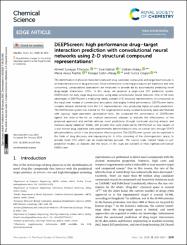| dc.contributor.author | Rifaioğlu, Ahmet Süreyya | |
| dc.contributor.author | Nalbat, Esra | |
| dc.contributor.author | Atalay, Volkan | |
| dc.contributor.author | Martin, Maria Jesus | |
| dc.contributor.author | Çetin-Atalay, Rengül | |
| dc.contributor.author | Doğan, Tunca | |
| dc.date.accessioned | 2020-05-24T15:31:50Z | |
| dc.date.available | 2020-05-24T15:31:50Z | |
| dc.date.issued | 2020 | |
| dc.identifier.citation | Rifaioglu, A.S., Nalbat, E., Atalay, V., Martin, M.J., Cetin-Atalay, R., Doǧan, T. (2020).
DEEPScreen: high performance drug-target interaction prediction with convolutional neural networks
using 2-D structural compound representations. Chemical Science, 11 (9), pp. 2531-2557.
https://doi.org/10.1039/c9sc03414e | en_US |
| dc.identifier.issn | 2041-6520 | |
| dc.identifier.issn | 2041-6539 | |
| dc.identifier.uri | https://doi.org/10.1039/c9sc03414e | |
| dc.identifier.uri | https://hdl.handle.net/20.500.12508/1127 | |
| dc.description | WOS: 000519240000025 | en_US |
| dc.description.abstract | The identification of physical interactions between drug candidate compounds and target biomolecules is an important process in drug discovery. Since conventional screening procedures are expensive and time consuming, computational approaches are employed to provide aid by automatically predicting novel drug-target interactions (DTIs). In this study, we propose a large-scale DTI prediction system, DEEPScreen, for early stage drug discovery, using deep convolutional neural networks. One of the main advantages of DEEPScreen is employing readily available 2-D structural representations of compounds at the input level instead of conventional descriptors that display limited performance. DEEPScreen learns complex features inherently from the 2-D representations, thus producing highly accurate predictions. The DEEPScreen system was trained for 704 target proteins (using curated bioactivity data) and finalized with rigorous hyper-parameter optimization tests. We compared the performance of DEEPScreen against the state-of-the-art on multiple benchmark datasets to indicate the effectiveness of the proposed approach and verified selected novel predictions through molecular docking analysis and literature-based validation. Finally, JAK proteins that were predicted by DEEPScreen as new targets of a well-known drug cladribine were experimentally demonstrated in vitro on cancer cells through STAT3 phosphorylation, which is the downstream effector protein. The DEEPScreen system can be exploited in the fields of drug discovery and repurposing for in silico screening of the chemogenomic space, to provide novel DTIs which can be experimentally pursued. The source code, trained "ready-to-use" prediction models, all datasets and the results of this study are available at ; https://github.com/cansyl/DEEPscreen. | en_US |
| dc.description.sponsorship | TUBITAK, TurkeyTurkiye Bilimsel ve Teknolojik Arastirma Kurumu (TUBITAK); British Council, UK [116E930]; European Molecular Biology Laboratory core funds | en_US |
| dc.description.sponsorship | This work was supported by the Newton/Katip Celebi Institutional Links program by TUBITAK, Turkey and British Council, UK (project no: 116E930, project acronym: CROssBAR), and the European Molecular Biology Laboratory core funds. | en_US |
| dc.language.iso | eng | en_US |
| dc.publisher | Royal Soc Chemistry | en_US |
| dc.relation.isversionof | 10.1039/c9sc03414e | en_US |
| dc.rights | info:eu-repo/semantics/openAccess | en_US |
| dc.subject.classification | Chemistry | en_US |
| dc.subject.classification | Multidisciplinary | en_US |
| dc.subject.classification | Ligands | Docking | Structure-based virtual | en_US |
| dc.subject.other | Discovery | en_US |
| dc.subject.other | Ligand | en_US |
| dc.subject.other | Inhibitors | en_US |
| dc.subject.other | Cladribine | en_US |
| dc.subject.other | Design | en_US |
| dc.subject.other | Renin | en_US |
| dc.subject.other | Derivatives | en_US |
| dc.subject.other | Docking | en_US |
| dc.subject.other | Potent | en_US |
| dc.subject.other | Benchmarking | en_US |
| dc.subject.other | Convolution | en_US |
| dc.subject.other | Convolutional neural networks | en_US |
| dc.subject.other | Deep neural networks | en_US |
| dc.subject.other | Forecasting | en_US |
| dc.subject.other | Proteins | en_US |
| dc.subject.other | Computational approach | en_US |
| dc.subject.other | Drug-target interactions | en_US |
| dc.subject.other | Hyper-parameter optimizations | en_US |
| dc.subject.other | In-silico screening | en_US |
| dc.subject.other | Physical interactions | en_US |
| dc.subject.other | Screening procedures | en_US |
| dc.subject.other | Structural compounds | en_US |
| dc.subject.other | Structural representation | en_US |
| dc.subject.other | Drug interactions | en_US |
| dc.title | DEEPScreen: high performance drug-target interaction prediction with convolutional neural networks using 2-D structural compound representations | en_US |
| dc.type | article | en_US |
| dc.relation.journal | Chemical Science | en_US |
| dc.contributor.department | Mühendislik ve Doğa Bilimleri Fakültesi -- Bilgisayar Mühendisliği Bölümü | en_US |
| dc.contributor.authorID | 0000-0001-6717-4767 | en_US |
| dc.contributor.authorID | 0000-0002-1298-9763 | |
| dc.contributor.authorID | 0000-0003-2408-6606 | |
| dc.identifier.volume | 11 | en_US |
| dc.identifier.issue | 9 | en_US |
| dc.identifier.startpage | 2531 | en_US |
| dc.identifier.endpage | 2557 | en_US |
| dc.relation.publicationcategory | Makale - Uluslararası Hakemli Dergi - Kurum Öğretim Elemanı | en_US |
| dc.contributor.isteauthor | Rifaioğlu, Ahmet Süreyya | en_US |
| dc.relation.index | Web of Science Core Collection - Science Citation Index Expanded | en_US |
| dc.relation.index | Web of Science - Scopus - PubMed | en_US |
















